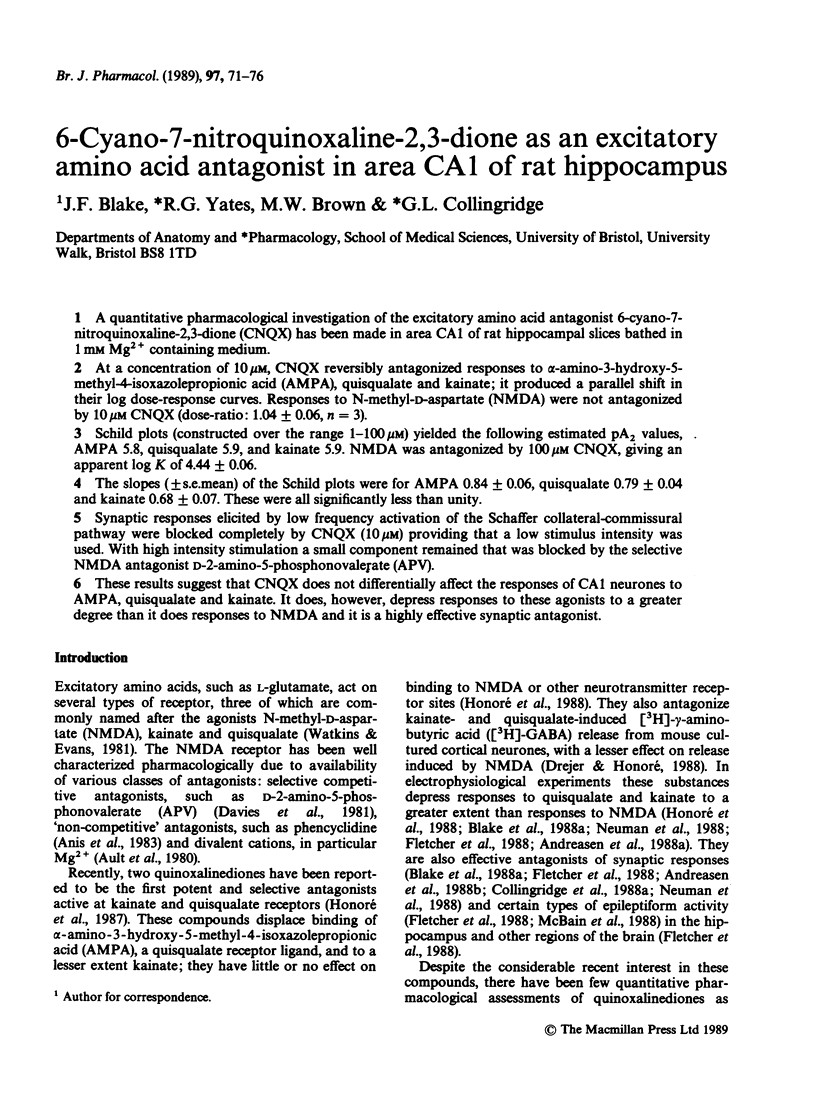Abstract
1. A quantitative pharmacological investigation of the excitatory amino acid antagonist 6-cyano-7-nitroquinoxaline-2,3-dione (CNQX) has been made in area CA1 of rat hippocampal slices bathed in 1 mM Mg2+ containing medium. 2. At a concentration of 10 microM, CNQX reversibly antagonized responses to alpha-amino-3-hydroxy-5-methyl-4-isoxazolepropionic acid (AMPA), quisqualate and kainate; it produced a parallel shift in their log dose-response curves. Responses to N-methyl-D-aspartate (NMDA) were not antagonized by 10 microM CNQX (dose-ratio: 1.04 +/- 0.06, n = 3). 3. Schild plots (constructed over the range 1-100 microM) yielded the following estimated pA2 values, AMPA 5.8, quisqualate 5.9, and kainate 5.9. NMDA was antagonized by 100 microM CNQX, giving an apparent log K of 4.44 +/- 0.06. 4. The slopes (+/- s.e. mean) of the Schild plots were for AMPA 0.84 +/- 0.06, quisqualate 0.79 +/- 0.04 and kainate 0.68 +/- 0.07. These were all significantly less than unity. 5. Synaptic responses elicited by low frequency activation of the Schaffer collateral-commissural pathway were blocked completely by CNQX (10 microM) providing that a low stimulus intensity was used. With high intensity stimulation a small component remained that was blocked by the selective NMDA antagonist D-2-amino-5-phosphonovalerate (APV). 6. These results suggest that CNQX does not differentially affect the responses of CA1 neurones to AMPA, quisqualate and kainate. It does, however, depress responses to these agonists to a greater degree than it does responses to NMDA and it is a highly effective synaptic antagonist.
Full text
PDF





Selected References
These references are in PubMed. This may not be the complete list of references from this article.
- Andreasen M., Lambert J. D., Jensen M. S. Direct demonstration of an N-methyl-D-aspartate receptor mediated component of excitatory synaptic transmission in area CA1 of the rat hippocampus. Neurosci Lett. 1988 Oct 31;93(1):61–66. doi: 10.1016/0304-3940(88)90013-4. [DOI] [PubMed] [Google Scholar]
- Anis N. A., Berry S. C., Burton N. R., Lodge D. The dissociative anaesthetics, ketamine and phencyclidine, selectively reduce excitation of central mammalian neurones by N-methyl-aspartate. Br J Pharmacol. 1983 Jun;79(2):565–575. doi: 10.1111/j.1476-5381.1983.tb11031.x. [DOI] [PMC free article] [PubMed] [Google Scholar]
- Ault B., Evans R. H., Francis A. A., Oakes D. J., Watkins J. C. Selective depression of excitatory amino acid induced depolarizations by magnesium ions in isolated spinal cord preparations. J Physiol. 1980 Oct;307:413–428. doi: 10.1113/jphysiol.1980.sp013443. [DOI] [PMC free article] [PubMed] [Google Scholar]
- Birch P. J., Grossman C. J., Hayes A. G. 6,7-Dinitro-quinoxaline-2,3-dion and 6-nitro,7-cyano-quinoxaline-2,3-dion antagonise responses to NMDA in the rat spinal cord via an action at the strychnine-insensitive glycine receptor. Eur J Pharmacol. 1988 Oct 26;156(1):177–180. doi: 10.1016/0014-2999(88)90163-x. [DOI] [PubMed] [Google Scholar]
- Blake J. F., Brown M. W., Collingridge G. L. A quantitative study of the actions of excitatory amino acids and antagonists in rat hippocampal slices. Br J Pharmacol. 1988 Sep;95(1):291–299. doi: 10.1111/j.1476-5381.1988.tb16576.x. [DOI] [PMC free article] [PubMed] [Google Scholar]
- Blake J. F., Brown M. W., Collingridge G. L. CNQX blocks acidic amino acid induced depolarizations and synaptic components mediated by non-NMDA receptors in rat hippocampal slices. Neurosci Lett. 1988 Jun 29;89(2):182–186. doi: 10.1016/0304-3940(88)90378-3. [DOI] [PubMed] [Google Scholar]
- Collingridge G. L., Herron C. E., Lester R. A. Synaptic activation of N-methyl-D-aspartate receptors in the Schaffer collateral-commissural pathway of rat hippocampus. J Physiol. 1988 May;399:283–300. doi: 10.1113/jphysiol.1988.sp017080. [DOI] [PMC free article] [PubMed] [Google Scholar]
- Davies J., Francis A. A., Jones A. W., Watkins J. C. 2-Amino-5-phosphonovalerate (2APV), a potent and selective antagonist of amino acid-induced and synaptic excitation. Neurosci Lett. 1981 Jan 1;21(1):77–81. doi: 10.1016/0304-3940(81)90061-6. [DOI] [PubMed] [Google Scholar]
- Drejer J., Honoré T. New quinoxalinediones show potent antagonism of quisqualate responses in cultured mouse cortical neurons. Neurosci Lett. 1988 Apr 22;87(1-2):104–108. doi: 10.1016/0304-3940(88)90153-x. [DOI] [PubMed] [Google Scholar]
- Edgley S. A., Jankowska E., Shefchyk S. Evidence that mid-lumbar neurones in reflex pathways from group II afferents are involved in locomotion in the cat. J Physiol. 1988 Sep;403:57–71. doi: 10.1113/jphysiol.1988.sp017238. [DOI] [PMC free article] [PubMed] [Google Scholar]
- Evans R. H., Evans S. J., Pook P. C., Sunter D. C. A comparison of excitatory amino acid antagonists acting at primary afferent C fibres and motoneurones of the isolated spinal cord of the rat. Br J Pharmacol. 1987 Jul;91(3):531–537. doi: 10.1111/j.1476-5381.1987.tb11246.x. [DOI] [PMC free article] [PubMed] [Google Scholar]
- Fletcher E. J., Martin D., Aram J. A., Lodge D., Honoré T. Quinoxalinediones selectively block quisqualate and kainate receptors and synaptic events in rat neocortex and hippocampus and frog spinal cord in vitro. Br J Pharmacol. 1988 Oct;95(2):585–597. doi: 10.1111/j.1476-5381.1988.tb11680.x. [DOI] [PMC free article] [PubMed] [Google Scholar]
- Honoré T., Davies S. N., Drejer J., Fletcher E. J., Jacobsen P., Lodge D., Nielsen F. E. Quinoxalinediones: potent competitive non-NMDA glutamate receptor antagonists. Science. 1988 Aug 5;241(4866):701–703. doi: 10.1126/science.2899909. [DOI] [PubMed] [Google Scholar]
- McBain C. J., Boden P., Hill R. G. The kainate/quisqualate receptor antagonist, CNQX, blocks the fast component of spontaneous epileptiform activity in organotypic cultures of rat hippocampus. Neurosci Lett. 1988 Nov 11;93(2-3):341–345. doi: 10.1016/0304-3940(88)90106-1. [DOI] [PubMed] [Google Scholar]
- Neuman R. S., Ben-Ari Y., Gho M., Cherubini E. Blockade of excitatory synaptic transmission by 6-cyano-7-nitroquinoxaline-2,3-dione (CNQX) in the hippocampus in vitro. Neurosci Lett. 1988 Sep 23;92(1):64–68. doi: 10.1016/0304-3940(88)90743-4. [DOI] [PubMed] [Google Scholar]
- Watkins J. C., Evans R. H. Excitatory amino acid transmitters. Annu Rev Pharmacol Toxicol. 1981;21:165–204. doi: 10.1146/annurev.pa.21.040181.001121. [DOI] [PubMed] [Google Scholar]


